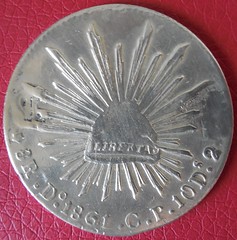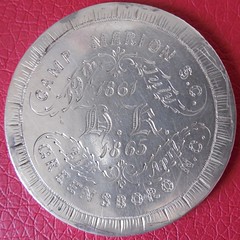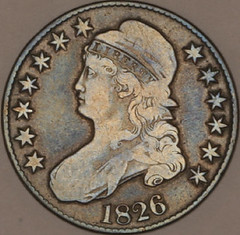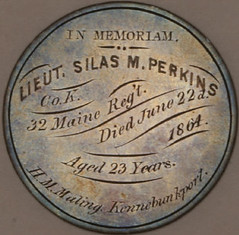
PREV ARTICLE
NEXT ARTICLE
FULL ISSUE
PREV FULL ISSUE
QUERY: ENGRAVED CONFEDERATE CAMP MARION COIN INFO SOUGHT
Web site visitor Nat Kaminski submitted these thoughts on a very interesting engraved coin with a connection to the last days of the U.S. Civil War. Wow!
-Editor


I'm trying to get some information about a coin that my great-grandfather obtained after his S.C. confederate unit surrendered in 1865. Photos of the coin are attached. It belongs to a family member, a private owner in Georgetown, S.C. There have been some stories passed down about his receiving this coin at the time his unit surrendered. But it looks to me as though he may have obtained it after the end of the war and had it engraved at some point. From looking on-line, I see where other similar coins were issued and hand-engraved. Can you point me to anyone who could tell me something about them: who issued them? when and where were they generally made? how did the soldiers obtain them? etc. This information is in a book published by Robert M. Dunkerly titled "The Confederate Surrender at Greensboro", published in 2013 by McFarland & Co., Inc. In the book, Dunkerly describes the last days of the Army of Tennessee which surrendered in disarray in April, 1865 while encamped in different locations in North Carolina, including Greensboro where my great grandfather's unit, The S.C. 10th Regiment, was bivouacked. Confederate General Johnston had assumed command of this army and announced on April 26th 1865 that he had surrendered to Union General Sherman. Just prior to the surrender, Confederate President Jeff Davis had directed General Johnston to send $37,680 in Mexican silver coins to Charlotte where Davis was then located. In an act of "defiance," General Johnston decided to distribute this coinage to the 32,174 men under his command to be used for "forage" on their way home. The dollar amount assigned to each coin apparently varied between $1.10 to $1.80. As Dunkerly states, "The differing amounts (of value) are hard to reconcile. This may be the result of a faulty distribution system, stealing, different distribution systems, or simply failing memories of those who wrote about the event. As the money went out to widely spread out commands, officers of the various units chose to distribute it differently." (p. 131-32) The book recounts various stories from some of the men who received the money, all of whom stated it was the most money they had seen "in a long while." As Dunkerly recounts, "This pitiful amount was the only payment received for months and was the first coin seen by many of the men during the war." Some of the men wrote later that they immediately spent the money in their effort to get home, but others decided to hold onto this payment as a treasured object. The book contains an excerpt from Confederate Captain Stoney's diary: "The brigade was paid today one dollar and a quarter in silver per man, the last I suppose of the Confederate treasury. I shall have mine made into a medal to keep and value as received from the dying hands of my government. It is the greatest earthly satisfaction, and only consolation now, that I entered her service on the day of the inauguration of this war; was never absent from my command except by authority or wounds, and continued in the field until the last day." My great grandfather must have fallen into this latter category, hanging onto this "payment" from the Confederate treasury as a reminder and memento. I think he was very respectful of that coin and what it represented. In my great grandfather's 1909 obituary, it states: "He continued with his command until the surrender in Greensboro, N.C. in 1865. When the army was disbanded his pay amounted to $1.10 in silver and with this sum as his cash capital he started for home to begin again his business and life." Apparently, like Captain Stoney, many of the men who kept the coin had it subsequently engraved in the form of a medal. I found an image of a very similar coin on the E-Sylum website from a 2011 posting where the engraving on the coin is very different. So I suspect very few of the surviving coins are alike, having been engraved at different locations with different markings according to the owner's wishes.


1864 Engraved coin from The E-Sylum At any rate, this account is in line with the oral tradition regarding this coin's provenance. I am glad to see it confirmed in a well-researched account of those last chaotic days of the Civil War. One could gather from Dunkerly's account that at least 32,000 of these coins were distributed in April, 1865. I wonder how many still survive? With regard to the coin itself, I was trying to determine what the markings on the back meant. It apparently is a Mexican Reales 8 silver coin. This is what Wickipedia says about it: "With the adoption of the 1824 republican constitution, the United Mexican States began issuing coins. There were silver ½, 1, 2, 4 and 8 reales, and gold ½, 1, 2, 4 and 8 escudos, with silver ¼ reales added in 1842. Copper coins for1⁄16, ⅛ and ¼ real were issued both by the Federal government at the Mexico City mint and by the state governments at various mints around the country. On the republic's coins, the Mexican eagle moved to the obverse, with the legend "República Mexicana". The reverse featured a liberty cap with rays behind. The legend on the reverse reads "-denomination- -mintmark- -date- -assayer's initials- 10 Ds. 20 Gs." Mexico used the medieval system of dineros and granos to measure the fineness of their coins, twelve dineros designating pure silver with each dinero divided into 24 granos. A coin of 10 Ds. 20 Gs equated to .902777 fine. The brief reign of Maximillian (1864–67) interrupted the production of republic type coins and many of the denominations ceased production either in 1863 or by 1870, as the decimal currency based on the peso was introduced. However, 8 reales coins continued in production until 1897." This explains what is on the back of my great grandfather's coin. It was a Mexican 8 Reales 10 dineros 20 granos, with the denomination, mintmark, date, and assayer's initials denoted.
So, can anyone help? Has anyone seen a coin like this before?
-Editor
To read the earlier E-Sylum article, see:
EXHIBIT: HAND-ENGRAVED CIVIL WAR SILVER COINS
(www.coinbooks.org/esylum_v14n01a14.html)
The Numismatic Bibliomania Society is a non-profit organization promoting numismatic literature. See our web site at coinbooks.org. To submit items for publication in The E-Sylum, write to the Editor at this address: whomren@gmail.com To subscribe go to: https://my.binhost.com/lists/listinfo/esylum All Rights Reserved. NBS Home Page Contact the NBS webmaster 
|